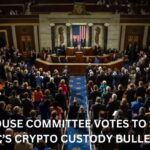Key Takeaways
- The US needs a CBDC, according to Fed Vice Chair Lael Brainard, to maintain the economic growth of the country in the future global digital financial sector.
- An emerging digital financial platform designed upon new digital assets and supported by crypto-asset platforms and stablecoins as settlement assets has seen explosive growth.
- Ms. Brainard testified before the House Financial Services Committee that a central bank digital currency might coexist and support stablecoins in the future by providing a publicly available, government-backed form of payment.
Lael Brainard, Vice Chair of the US Federal Reserve, has reawakened interest in crypto, recognizing the need for a central bank digital currency based on the US dollar and its ability to coexist alongside stablecoins. Brainard elaborates on the importance of adopting digital money and the consequences of not connecting with the future digital financial system, even putting a 5-year timetable on the debut of the digital dollar.

Her remarks were made public ahead of her May 26 testimony before the Committee on Financial Services of the United States House of Representatives.
According to Brainard:
“Given the rapid expansion of the digital financial system at both the national and international levels, the question should be framed not as to whether there is a need for a central-bank-issued digital dollar today, but rather as to whether such a need may arise in the future.” We understand that there are dangers in not acting, just as there are dangers in acting.”
Physical currency gives the general public access to reliable central bank money that may be exchanged without fear of liquidity or credit risk. In just five years, the percentage of cash payments in the United States has dropped from 31% to 20%, and the percentage is substantially lower for those under 45. Consumers and businesses do not now assess whether the money they are using is a central bank obligation, such as cash, or a commercial bank liability, such as bank deposits. Deposit insurance, banks’ access to central bank liquidity, and banking supervision and regulation all contribute to the faith in commercial bank money.
Digital asset adoption is unquestionably increasing, and Brainard believes that CBDCs might coexist and support cryptocurrencies.
“In some future scenarios, CBDC might coexist with and complement stablecoins and commercial bank money in the digital financial ecosystem by providing a safe central bank liability, similar to how cash today coexists with commercial bank money.”
However, the implementation of CBDC will be fraught with dangers. The digital dollar could be used to replace commercial bank money, lowering overall bank deposits. CBDCs may also be preferred by people when they are stressed.
Addressing some bankers’ worries that a digital dollar would take a big and potentially fatal chunk out of their deposit business, Brainard said it’s “probably best not to have an interest-bearing digital currency.” She also indicated that the Fed is considering imposing limits on digital dollar holdings in order to encourage users to use them just for payments rather than as a safe haven for individuals or businesses to invest their money.
Having a digital dollar may assist the US to assure that dollar users all around the world can trust the money and transact with it. Furthermore, according to Brainard, the United States must play a prominent role in establishing the regulating standards for CBDC transactions in order to assure confidentiality, availability, interoperability, and safety.
Despite President Biden’s executive order in March stating that “maximum urgency” should be given to examining the designs, dangers, and necessity for a CBDC, Fed policymakers remain split on the issue. For example, Federal Reserve Governor Christopher Waller is suspicious of CBDCs and has expressed privacy concerns.
Fed Vice Chair believes Digital Dollar Could co-exist with Stablecoins:
Brainard’s comments come as the Federal Reserve considers a potential new form of money to keep up with private-sector payment innovations, such as stablecoins, which are a type of cryptocurrency that is tied to the dollar or another national currency.
An emerging digital financial system based on new digital assets and assisted by crypto-asset platforms and stablecoins as settlement assets has seen spectacular growth. Two frequently used stablecoins have been under a lot of strain in recent weeks. One of the most extensively used algorithmic stablecoins has dropped to a fraction of its supposed value, while the most traded crypto asset by volume has momentarily fallen below its alleged one-to-one dollar price.
This month, regulators focused their attention on stablecoins again after the value of TerraUSD, one of the largest stablecoins at the time, plummeted below a dollar.
“The recent volatility in crypto financial markets demonstrates that the steps we take now—whether on the regulatory framework or a digital currency—must be resilient to the financial system’s future evolution,” Ms. Brainard added.
Given the current bearish stand of the crypto market, the world’s largest economy’s support and conviction in the value and significance of digital assets speak to the vital role that crypto will continue to be a huge part in the future of finance.











